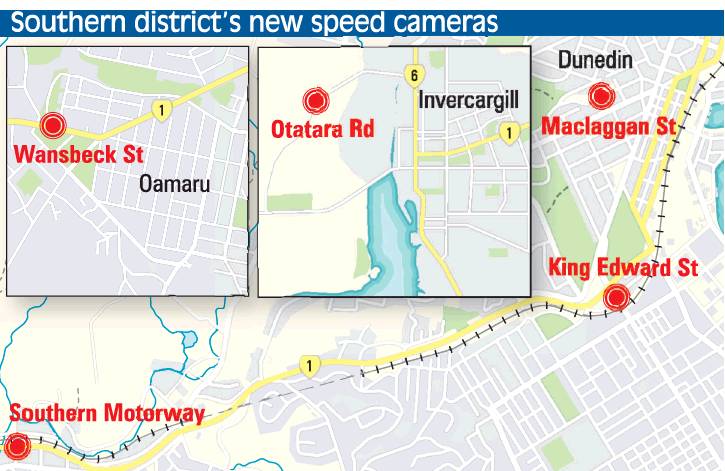
The cameras are to be installed at the northern end of King Edward St in South Dunedin, on the Southern Motorway at Burnside and in Maclaggan St.
The Oamaru camera will be on Wansbeck St, on SH1 to the south of the town, and another will be on Otatara Rd, Invercargill.
The Automobile Association said crash history and predictive analysis of potential crash spots had been used to identify the sites, and it was mostly comfortable with work the police had done to identify them.
AA Otago district council chairman Alan Race said if the cameras were being deployed in areas that would promote safer driving and reduce crashes, "I believe the AA would be supportive".
However if a "a bit of extra speed hadn’t done any harm" the AA might be concerned about it.
Mr Race said he thought at the Maclaggan St site "the average speed is above the speed limit".
He did not know what the crash statistics were for the street.
King Edward St was also likely to be a place where people drove over the speed limit, particularly as the road got closer to the South Dunedin shopping area.
Police yesterday said the cameras would be in place by the end of the year but a spokeswoman said there was no confirmed installation timetable.
AA Research Foundation manager Simon Douglas, of Wellington, said the organisation had been engaged in discussions on speed camera locations for about 18 months.
He said police were using an evidence-driven programme to find the best locations.
"By and large, we are happy that the process they’ve been through takes the best evidence available in terms of potential crash risk related to speed, and places the cameras at those points."
Mr Douglas said when deciding on the sites, police used the NZ Transport Agency’s crash analysis system, but analysing crash sites could be "a little bit like chasing lightning".
That a crash had not occurred at a site did not mean that it was not a high-risk site.
The NZTA and a consultant had developed a system that considered road curvature, the road shoulder and aspects like street furniture, and combined them with crash history to find parts of the road at high risk of crashes.
"What we’ve seen at some of the sites where speed cameras are to be placed, it doesn’t look to the casual observer that there’s been a lot of accidents there."
Details and methodology used gave a more detailed idea of the risk of the site.
"It’s the crash history, but it’s also a bit predictive."
Mr Douglas said local AA districts would stay involved in the process, and the organisation would continue to engage with police as they rolled out the cameras, to make sure the AA was "still comfortable".
The Dunedin cameras are among 33 new digital speed cameras set to be installed across the country.
It is the third phase of the $10million speed camera expansion programme announced in July 2013, in which 56 fixed cameras will be placed at high-risk sites. The new cameras use a dual radar system to monitor up to six lanes of traffic flowing in both directions, and will take digital images sent wirelessly through a secure network. They can detect heavy and towing vehicles, and create no visible flash.












